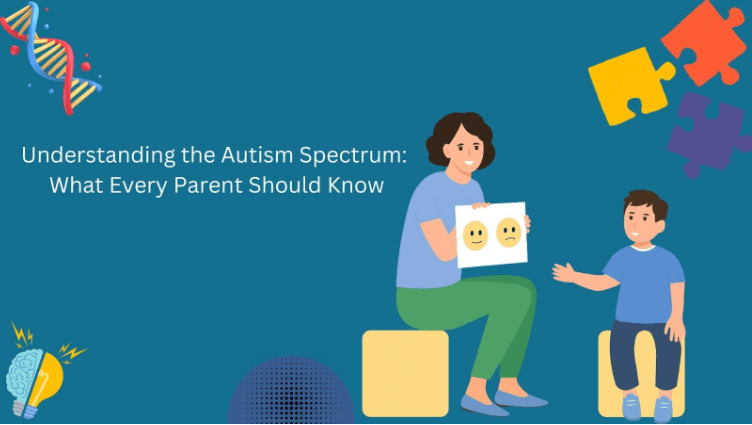Education
Understanding the Autism Spectrum: What Every Parent Should Know

The term autism spectrum encompasses a range of developmental disorders characterized by repetitive behaviors, challenges in communication, and difficulties with social interaction. As a spectrum disorder, it includes a wide variety of symptoms and severity levels, from significant developmental challenges to subtle traits that may go undiagnosed in high-functioning individuals. Understanding these nuances is essential for parents who aim to provide the right support for their child’s unique needs and foster their development effectively.
Table of Contents
Handling the Diverse Manifestations of Autism
Autism presents differently in each child, ranging from mild social challenges to severe language difficulties that require significant support. Symptoms can also change as a child grows, making it important for parents to adapt their approaches over time.
Gender differences play a key role in autism expression. Boys are diagnosed more frequently than girls, partly because autism traits in girls can be more subtle. Girls may mask symptoms through social mimicry or focus on interests that align with traditional gender norms, such as reading or animals, while boys may show a stronger interest in mechanical objects. Recognizing these gender-specific patterns can help ensure timely diagnosis and intervention.
Children with autism often experience co-occurring conditions like ADHD, anxiety, or sensory processing issues. Acknowledging these overlapping disorders is crucial for developing a comprehensive treatment plan. Additionally, the administrative side of autism management, like keeping up with ABA therapy billing and handling insurance services, plays an essential role in maintaining access to therapies that address these diverse needs.
Important Behavioral Features and Their Consequences
Numerous behaviors that impact social interaction, communication, and day-to-day functioning are indicative of autism. To effectively handle these features, it’s critical to recognize them.
Communication Difficulties
Children with autism often face challenges in verbal and nonverbal communication, ranging from speech delays to difficulties with conversation flow and understanding social cues. Some may struggle with nonverbal signals like gestures or facial expressions. Alternative communication methods, such as picture cards, sign language, or communication devices, can help bridge these gaps and support language development.
Social Interaction Differences
Children with autism often face challenges in social interaction, such as difficulty understanding social norms, avoiding eye contact, or showing limited interest in playing with peers. These challenges stem from a different way of interpreting social cues rather than a lack of desire to interact. Structured activities like role-playing, guided interactions, and social storytelling can help gradually build social skills.
Repetitive Behaviors and Routines in Autism
Autism is often associated with repetitive behaviors like hand-flapping, rocking, or a strong preference for routines. These behaviors may seem unusual but serve a functional purpose for individuals on the spectrum. Repetitive behaviors offer comfort and predictability, helping individuals manage sensory input in a structured way. They can reduce anxiety by providing a sense of control in an otherwise overwhelming environment. Gradual behavioral interventions, such as Applied Behavior Analysis (ABA) therapy, can introduce flexibility while respecting the individual’s need for consistency. Managing administrative aspects like ABA therapy billing is also important to ensure seamless access to these therapeutic services.
The Diagnostic Process: A Guide for Parents
Diagnosing autism is rarely straightforward and typically involves multiple steps or sessions.
Early detection is crucial, as scientific evidence shows that early intervention provides long-term benefits for children.
Screening and Evaluation Process
The process often begins with routine developmental checkups, where screening tools like the Modified Checklist for Autism in Toddlers (M-CHAT) are used. If signs of autism are detected, a comprehensive multidisciplinary evaluation follows. The assessment team may include a developmental pediatrician, child psychologist, speech and language pathologist, and occupational therapist. An AI-powered workspace for therapy billing can enhance this process by providing real-time tracking of payments and streamlining the entire billing and credentialing process, ensuring that therapists and parents can focus on the child’s care without administrative delays.
Common Diagnostic Tools and Methods
Diagnosis involves direct observation of the child, interviews with parents, and standardized developmental checklists. Assessments focus on various areas such as communication, social interaction, and play. These tools provide a well-rounded view of the child’s strengths and challenges, aiding in creating a tailored support plan. Once the evaluation is complete, parents may also need to navigate practical considerations, such as managing ABA therapy billing to ensure smooth access to recommended treatments.
Managing Sensory Sensitivities in a Sensory-Friendly Environment
It is common for children with autism to react abnormally to sounds, textures, lighting, and even tastes. Hypersensitivity or hyposensitivity are two possible manifestations of these sensory processing problems.
Recognizing Problems with Sensory Processing
A hypersensitive child can, for instance, refuse to wear particular textures or cover their ears when exposed to loud noises. On the other hand, a hypersensitive child might crash into things or chew on things that aren’t food to get more sensory input. Parents can create effective management methods for their children by acknowledging these sensory needs.
Creating a Sensory-Friendly Home Environment
Designing a sensory-friendly environment can significantly enhance a child’s comfort. This may include calming elements like weighted blankets, noise-canceling headphones, or dim lighting to help with self-regulation. Incorporating sensory-friendly activities, such as swinging or tactile play, into their routine can also support sensory integration.
Role of Early Intervention and Tailored Therapies
Studies show that timely and appropriate interventions can significantly improve outcomes for young children with autism. The benefits extend beyond early therapy initiation to include the type of intervention used and the individual characteristics of the child.
Impact of Early Intervention
These therapies, including ABA therapy, speech therapy, and occupational therapy, aim to develop essential skills and reduce the challenges associated with autism. They focus on teaching new behaviors, managing difficult behaviors, and fostering communication and social skills. Additionally, handling administrative aspects such as ABA therapy billing is important for ensuring seamless access to these critical services.
Choosing the Right Interventions
Every child with autism is unique, and the impact of treatment can vary. All clients receive a treatment plan prepared by several specialists simultaneously, covering communication, socialization, and sensory integration. Along with therapeutic approaches, managing administrative tasks like ABA therapy billing is essential to ensure families can access the necessary services without financial or logistical disruptions.
Establishing a Support System and Using Available Resources
It is important also to note that autism is not an issue that parents should face on their own. Getting support can help you acquire invaluable tools, advice, and, sometimes, consolation.
Online and Community Support
Parents can exchange information, or depend upon workshops, online forums, and support groups to know about new techniques and therapies. It can be useful at some point in life to communicate with other parents, who understand that it is not easy to raise a kid with autism.
Educational Advocacy
Education can be very challenging, especially when trying to secure instructional rights and support. The parents need to ensure that their child is taught in a way that targets his/her learning style disability and that parents need to get familiar with the concept of IEP. To excel in school, a youngster needs to understand these resources.
FAQ
- How important is early diagnosis for children with autism?
Early diagnosis is essential because it enables early intervention, which can greatly enhance social skills, adaptive behaviors, and communication results. Children have the best chance for long-term development when interventions are started as soon as possible.
- How long does it typically take to diagnose autism?
The process typically involves multiple appointments over several weeks or months. It begins with an initial screening, followed by comprehensive evaluations carried out by various professionals.
- Are there therapies specifically suited for high-functioning children on the spectrum?
While therapies like ABA are widely used, children with high-functioning autism may benefit more from social skills training, cognitive-behavioral therapy, or targeted occupational therapy that addresses specific challenges such as sensory issues or executive functioning skills.
Conclusion
Managing the autism spectrum necessitates a customized strategy that takes into consideration its many expressions. Parents can better assist their children’s development by identifying gender-specific features, co-occurring conditions, and each child’s particular abilities. A sensory-friendly atmosphere, individualized therapies, and early intervention are crucial actions that have a big impact. With the correct tools and a solid support system, parents can enable their kids to flourish and realize their full potential.

-

 Business3 years ago
Business3 years agoHow to Do Long-Distance Moves with Children
-

 Business2 years ago
Business2 years agoThe Ultimate Guide To Thriving In Your Printing Franchise
-

 Business2 years ago
Business2 years agoExploring The Benefits And Challenges Of Restaurant Franchising
-

 Business4 years ago
Business4 years agoIs Guest Posting a Good Inbound Marketing Strategy?
-

 Travel2 years ago
Travel2 years agoQuick Guide: Moving To Santa Rosa?
-

 Tech3 years ago
Tech3 years agoCyber Table That Will Change Your Life
-

 Real Estate3 years ago
Real Estate3 years agoWhy Dubai Festival City is a Great Neighbourhood for Young Learners
-

 Lifestyle2 years ago
Lifestyle2 years agoDallas’ Hidden Gems: 6 Must-Try Restaurants Off The Beaten Path!









Recent Comments